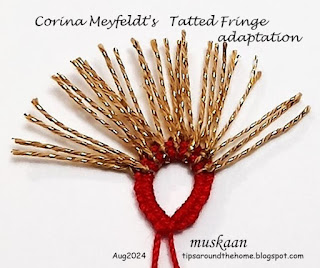Whatever it is, I'm sure happy to pause and share this slightly mixed bag of fun and possibilities! Let's start with the Tatted Fringe and adaptations and practice pattern I shared in my last two posts.
Yesterday Elisabeth Dobler wrote to me and sent me some photos which I share here with her kind permission. And this is what she says -
Today our tatting group met again and I showed them the new technique of Corina Meyfeldt and you. It was so funny - we had so much fun! Some members of my group were so creative and tried new ways to apply this new technique. Initially I wanted to teach them the various possibilities of the captured picot but we didn't have enough time - we tatted 3 hours only the new technique!
Thank you very much for sharing this new skills!
I like your fringed star. The colors are pretty and I don’t mind ‘messy’ fringe.It looks nice to me.
Got me thinking – do you think we could do something similar using the daisy picot technique? Long picots *between* the daisy picot stitches, then cut them after we’re finished? I don’t have time to try it now, but it sounds like it would work….in my head, at least.
And the answer is yes! sorry I didn't get time to try it out, but this is the only caveat to keep in mind - if we attach the fringe to the core thread, it will take up space like any stitch. Hence if a pattern is not written with a fringe in mind, one must take care to adjust the total stitches accordingly. Of course, this can be countered by adding the fringe to the picot thread, and if one wants the fringe facing down/inwards, then tat a downward or inward facing picot on which you attach the fringe!
I didn't mention it in my last post, but I had used the spot fringe as thorns in the tiny Thorny Wreath from 2015. (https://tipsaroundthehome.blogspot.com/2015/12/thorny-wreath-pattern.html)
And this Christmas Troll (Ruth Perry's pattern) where I frayed the picots for an afro, could well have had additional fringe to give it a denser style (https://tipsaroundthehome.blogspot.com/2016/12/a-new-look-or.html)










































